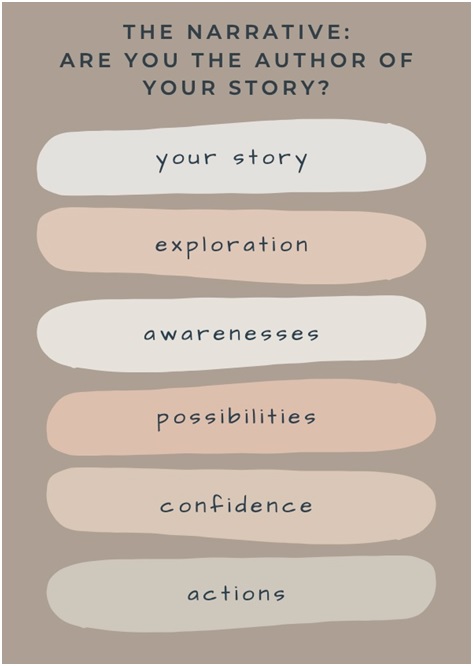A Coaching Model By Juliana Landmann, Transition Coach, SWITZERLAND
The Model Narrative
The Narrative Coaching Model takes into consideration that all of us, no matter what age, culture or gender create narratives about ourselves. These narratives are influenced by our experiences, families, culture, friends, education, and everything that surrounds us and that shapes us into who we are and how we perceive ourselves and the world.
We all encounter difficulties distinguishing our thoughts and feelings about events from the facts of the events themselves and don’t realize that every narrative is invented and created by us, based on our perception, interpretation of events, and experiences and is, therefore, biased and not necessarily the only truth available.
Without even noticing, our brain automatically groups the assumptions and thoughts we created about the facts into patterns and retains the new story as the truth. But these abstractions and assumptions that we treat as physical reality, can block us from seeing things as they are and end up reducing our power to accomplish what we want.
The circumstances that we live in are the facts, but what we make of them or, what narratives we tell ourselves about them, is what allows us to become the authors of our own stories.
Research in cognitive psychology shows that stories are how we remember things.[1] They can also set the framework for how our lives will unfold, therefore we must tell ourselves a story that we desire to live in.
But to be able to write our own stories, we need to first become aware that we are their sole creators. Then we need to be willing to explore what parts are facts or fiction created by our mind, what is serving us, which chapters we would like to re-write, and with what content.
The Narrative Coaching model is based on 6 steps that will help clients separate the conclusions they make from facts from the facts themselves, allowing them to break free of the framework of their own narrative that is keeping them stuck until a world of possibilities opens up for them. A world where they can choose which story they want to tell themselves that will allow them to live the life they wish.
Your Story:
Every client is unique and brings with them their own story. At this first stage, the coach offers a safe and trusted space for the client to open up and feel heard. The coach’s presence and ability to listen to the client with genuine curiosity and judgment-free helps create a strong partnership that will be needed for the client to dive into their inner self, understand their narratives and be able to rewrite them.
Exploration:
When clients go through a transition in their lives, often they feel disconnected from themselves, stuck, and lost. The process of exploration helps them to reconnect with their values, strengths and what is important for them, and what they want more of in their lives. After a story is told, it is the coach’s job to ask powerful questions to help the client distinguish assumptions and conclusions from true facts and circumstances. With the unfold of every question, the client dives deeper into their thoughts, feelings, beliefs, and perceptions of the world and themselves.
Awarenesses:
As in any narrative, there comes a moment of climax which I like to think in a coaching context of being the awareness that comes to light. This is when underlying beliefs and assumptions surface, allowing the client to see through their story and understand the impact their narrative has on how their life is unfolding. Once the spotlight is on the self and not on the old story, the client gains the power to focus the light on whatever direction she/he wants the story to go, opening up for new options and choices.
Possibilities:
The client has gained the power to choose the perspective that she/he wants to view themselves with and in which direction they would like to go. This is a place where choices become available for their new story to be written, their brain rewired, and their life to take a new meaning.
Confidence:
By borrowing techniques from Positive Psychology, Appreciative Inquiry, and Brain-Based Coaching, the coach can help the client; find self-trust, remove any self-doubt that might come in the way, allow them to visualize all their accomplishments, get in touch with their skills/ talents and thus give them the boost of confidence needed for them to feel motivated and move forward.
Action:
Most people don’t get into action because they are scared of the uncertainty around not knowing where they are moving to or what will happen if they fail. But not taking any action is an action in itself that will keep them stuck on an overthinking loop. Thus, now that the client has figured out what narrative they want to tell themselves, creating small digestible action steps will help them to write each chapter as a new milestone that they wish to live in, allowing them to continue their story as they envisioned it and finally becoming the real authors of their lives.
Learn How to Create Your Own Coaching Model
Your Coaching Model reflects your values,
philosophies and beliefs and must communicate who you will coach
and the problems you will solve. Read more about creating your coaching model
References
Fryer, Bronwyn. Storytelling That Moves People.
Zander, R. and Zander, B. The Art of possibility. Camberwell, Vic.: Penguin.
[1]Fryer, Bronwyn. Storytelling That Moves People.
